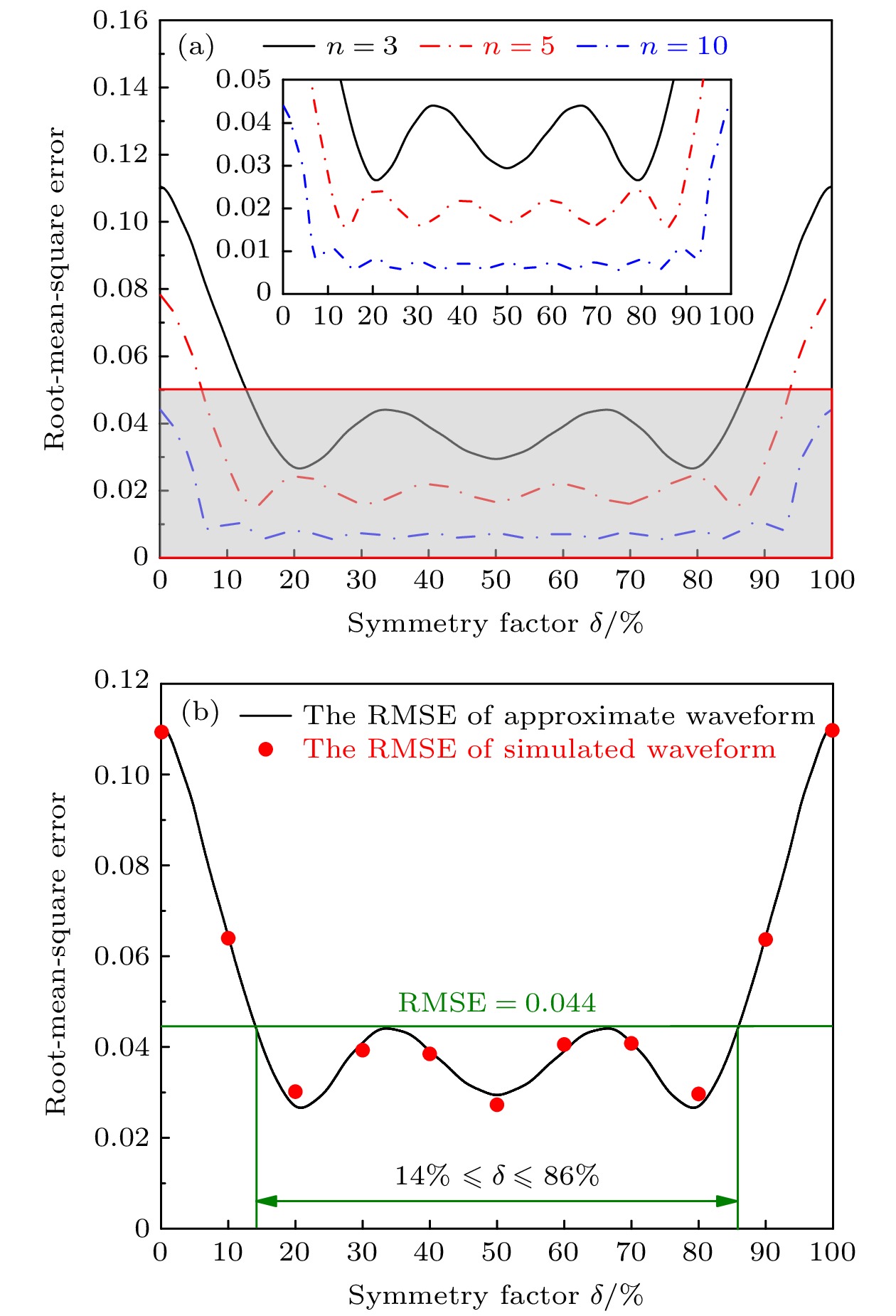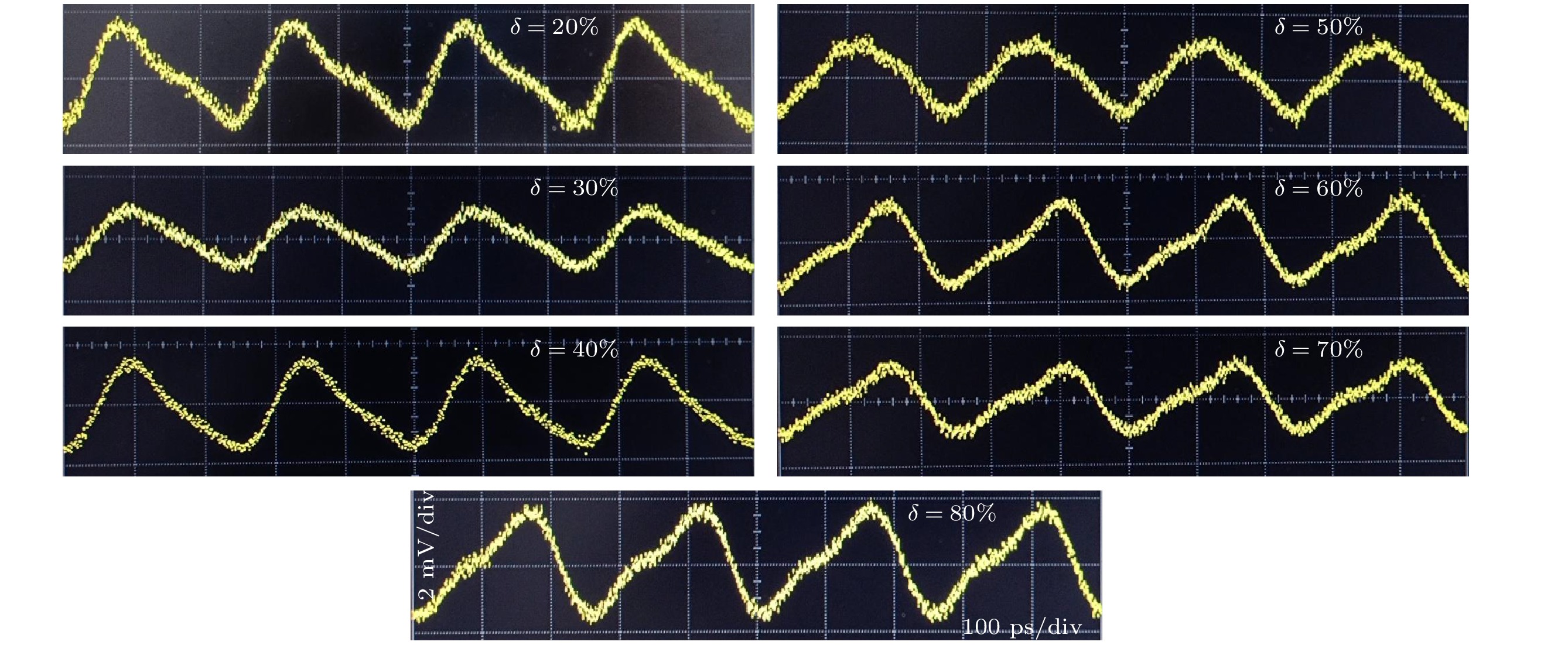-
提出并验证了一种基于双偏振调制生成可变对称三角波形的方法. 通过设置合适的调制器的调制指数和移相器的相移, 使得调制器生成信号光的强度近似等于理想三角波形傅里叶级数展开式的前三项, 从而生成不同对称因子的三角波形(三阶近似波形). 之前的三角波形生成方案大多生成对称三角波形或锯齿波形(锯齿波形可认为是非对称三角波形), 且对称因子不可调谐, 而本方案生成的三角波形的对称因子可调谐范围可达0%—100%, 这极大地拓展了三角波形的应用范围. 引入均方根误差(root-mean-square error, RMSE)来衡量生成波形与理论波形的相似度, 计算可发现, 理论上本方案生成的对称因子范围在14%—86%的三角波形与理想波形有良好的相似度(RMSE < 0.044), 仿真中生成波形的RMSE也非常接近理论误差. 在实验中, 通过使用频率为4GHz的射频信号生成了对称因子范围在20%—80%的三角波形.Photonic generation of triangular-shaped waveform with variable symmetry based on dual-polarization modulation is proposed and demonstrated. Based on the external modulation method, a dual-polarization modulator is used to modulate the radio frequency signal to generate the needed optical signal. By setting the modulation index of the modulator and phase shift of phase shifters appropriately, the optical intensity of generated signal can equal approximately the first three terms of the Fourier series expansion of the ideal triangular-shaped waveform, so triangular-shaped waveforms with different symmetry factors can be generated. Most of previous triangular waveform generation schemes generate symmetrical triangular waveform or sawtooth waveform (sawtooth waveform can be regarded as an asymmetrical triangular waveform), and the symmetry factor is not tunable. The tunable range of symmetry factor of triangular-shaped waveform generated by this scheme can reach 0%–100%, which will greatly expand the application range of triangular-shaped waveforms. The root-mean-square error (RMSE) is introduced to measure the similarity between the generated waveform and the theoretical waveform. It can be found that theoretically the triangular-shaped waveform with a symmetry factor in a range from 14% to 86% has a good similarity to the ideal waveform (RMSE < 0.044), and the RMSE of the generated waveform in the simulation is also very close to the theoretical RMSE. Experimentally, the 4GHz triangular-shaped waveforms with different values of symmetry factor (20%–80%) are obtained by using 4GHz radio frequency signal.
-
Keywords:
- triangular-shaped waveform /
- dual-polarization modulation /
- Fourier series expansion /
- root-mean-square error
[1] Bhamber R S, Latkin A I, Boscolo S, Turitsyn S K 2008 34th European Conference on Optical Communication, September 21–25, 2008 p1
[2] Cho S W, Rassau A, Gornisiewicz W 2007 6th International Conference on Polymers and Adhesives in Microelectronics and Photonics, January 16–18, 2007 p217
[3] Xu S Z, Wang P, Dong Y G 2016 Sensors 16 576
 Google Scholar
Google Scholar
[4] Won Y S, Kim C H, Lee S G 2015 IEEE Sens. J. 15 7142
 Google Scholar
Google Scholar
[5] Verscheure N, Finot C 2011 Electron. Lett. 47 1194
 Google Scholar
Google Scholar
[6] Ye J, Yan L S, Pan W, Luo B, Zou X H, Yi A L, Yao S 2011 Opt. Lett. 36 1458
 Google Scholar
Google Scholar
[7] Jiang H Y, Yan L S, Sun Y F, Ye J, Pan W, Luo B, Zou X H 2013 Opt. Express 21 6488
 Google Scholar
Google Scholar
[8] Li W, Wang W Y, Sun W H, Wang W T, Liu J G, Zhu N H 2014 Opt. Lett. 39 4758
 Google Scholar
Google Scholar
[9] Dai B, Gao Z S, Wang X, Chen H W, Kataoka N, Wada N 2013 J. LightwaveTechnol. 31 145
 Google Scholar
Google Scholar
[10] Li J, Ning T G, Pei L, Zheng J J, Li Y Q, Yuan J, Wang Y Q, Zhang C, Chen H Y 2014 Chin. Opt. Lett. 12 120602
 Google Scholar
Google Scholar
[11] Gao Y S, Wen A J, Liu W Y, Zhang H X, Xiang S Y 2016 IEEE Photonics J. 8 7801609
 Google Scholar
Google Scholar
[12] Li W, Wang W T, Zhu N H 2014 IEEE Photonics J. 6 5500608
 Google Scholar
Google Scholar
[13] Liu X K, Pan W, Zou X H, Zheng D, Yan L S, Luo B, Lu B 2014 J. Lightwave Technol. 32 3797
 Google Scholar
Google Scholar
[14] Huang L, Chen D L, Wang P, Zhang T T, Xiang P, Zhang Y Y, Pu T, Chen X F 2015 IEEE Photonics Technol. Lett. 27 2500
 Google Scholar
Google Scholar
[15] Wang W Y, Li W, Sun W H, Wang W T, Liu J G, Zhu N H 2015 IEEE Photonics Technol. Lett. 27 522
 Google Scholar
Google Scholar
[16] Li Y Y, Wen A J, Zhang W, Wang Q, Li X R 2019 Opt. Commun. 445 231
 Google Scholar
Google Scholar
[17] He Y T, Jiang Y, Zi Y J, Bai G F, Tian J, Xia Y, Zhang X Y, Dong R Y, Luo H 2018 Opt. Express 26 7829
 Google Scholar
Google Scholar
[18] Wei C, Jiang Y, Luo H, Dong R Y, Tian J, Zi Y J, Liu H F, Wang R 2020 Opt. Express 28 8098
 Google Scholar
Google Scholar
[19] Xia Y, Jiang Y, Zi Y J, He Y T, Tian J, Zhang X Y, Luo H, Dong R Y 2018 Opt. Commun. 414 177
 Google Scholar
Google Scholar
[20] Bai G F, Hu L, Jiang Y, Tian J, Zi Y J, Wu T W, Huang F Q 2017 Opt. Commun. 396 134
 Google Scholar
Google Scholar
[21] Li J, Ning T G, Pei L, Zheng J J 2019 J. Mod. Opt. 66 1457
 Google Scholar
Google Scholar
-
图 2 可变对称三角波形生成方案的原理示意图. CW laser, 连续波激光器; PC, 偏振控制器; RF source, 射频源; EPS, 电功分器; EA, 电放大器; PS, 电移相器; OPS, 光功分器; MZM, 单驱动马赫曾德尔调制器; PBC, 偏振合束器; 90°PR, 90°偏振旋转器; PD, 光电探测器
Fig. 2. Schematic diagram of the proposed scheme. CW laser, continuous wave laser; PC, polarization controller; RF source, radio frequency source; EPS, electrical power splitter; EA, electrical amplifier; PS, phase shifter; OPS, optical power splitter; MZM, single-drive Mach-Zehnder Modulator; PBC, polarization beam combiner; 90° PR, 90° polarization rotator; PD, photodiode.
图 7 可变对称三角波形生成方案的实验平台. Dual-wavelength laser, 双波长激光器; Polarization controller, 偏振控制器; Signal generator, 信号发生器; Power splitter, 电功分器; Electrical delay line, 电延迟线; Electrical amplifier, 电放大器; 180° hybrid coupler, 180°电桥; DP-BPSK modulator, 双偏振BPSK调制器; Photodiode, 光电探测器; Oscilloscope, 示波器
Fig. 7. Experimental platform for triangular-shaped waveform with variable symmetry generation scheme.
表 1 不同对称因子三角波形的生成条件
Table 1. Generated conditions for triangular-shaped waveforms with different symmetry factor.
对称因子 相移1 相移2 相移3 调制系数1 调制系数2 δ θ1 θ2 θ3 m1 m2 0% 0 π/4 0 1.15 0.83 10% 0 π/4 0 1.1 0.81 20% 0 π/4 0 0.92 0.76 30% 0 π/4 0 0.49 0.53 40% π/2 π/2 3π/2 0.61 0.41 50% π/2 0 3π/2 0.76 0 60% π/2 0 3π/2 0.61 0.41 70% 0 3π/4 0 0.49 0.53 80% 0 3π/4 0 0.92 0.76 90% 0 3π/4 0 1.1 0.81 100% 0 3π/4 0 1.15 0.83 -
[1] Bhamber R S, Latkin A I, Boscolo S, Turitsyn S K 2008 34th European Conference on Optical Communication, September 21–25, 2008 p1
[2] Cho S W, Rassau A, Gornisiewicz W 2007 6th International Conference on Polymers and Adhesives in Microelectronics and Photonics, January 16–18, 2007 p217
[3] Xu S Z, Wang P, Dong Y G 2016 Sensors 16 576
 Google Scholar
Google Scholar
[4] Won Y S, Kim C H, Lee S G 2015 IEEE Sens. J. 15 7142
 Google Scholar
Google Scholar
[5] Verscheure N, Finot C 2011 Electron. Lett. 47 1194
 Google Scholar
Google Scholar
[6] Ye J, Yan L S, Pan W, Luo B, Zou X H, Yi A L, Yao S 2011 Opt. Lett. 36 1458
 Google Scholar
Google Scholar
[7] Jiang H Y, Yan L S, Sun Y F, Ye J, Pan W, Luo B, Zou X H 2013 Opt. Express 21 6488
 Google Scholar
Google Scholar
[8] Li W, Wang W Y, Sun W H, Wang W T, Liu J G, Zhu N H 2014 Opt. Lett. 39 4758
 Google Scholar
Google Scholar
[9] Dai B, Gao Z S, Wang X, Chen H W, Kataoka N, Wada N 2013 J. LightwaveTechnol. 31 145
 Google Scholar
Google Scholar
[10] Li J, Ning T G, Pei L, Zheng J J, Li Y Q, Yuan J, Wang Y Q, Zhang C, Chen H Y 2014 Chin. Opt. Lett. 12 120602
 Google Scholar
Google Scholar
[11] Gao Y S, Wen A J, Liu W Y, Zhang H X, Xiang S Y 2016 IEEE Photonics J. 8 7801609
 Google Scholar
Google Scholar
[12] Li W, Wang W T, Zhu N H 2014 IEEE Photonics J. 6 5500608
 Google Scholar
Google Scholar
[13] Liu X K, Pan W, Zou X H, Zheng D, Yan L S, Luo B, Lu B 2014 J. Lightwave Technol. 32 3797
 Google Scholar
Google Scholar
[14] Huang L, Chen D L, Wang P, Zhang T T, Xiang P, Zhang Y Y, Pu T, Chen X F 2015 IEEE Photonics Technol. Lett. 27 2500
 Google Scholar
Google Scholar
[15] Wang W Y, Li W, Sun W H, Wang W T, Liu J G, Zhu N H 2015 IEEE Photonics Technol. Lett. 27 522
 Google Scholar
Google Scholar
[16] Li Y Y, Wen A J, Zhang W, Wang Q, Li X R 2019 Opt. Commun. 445 231
 Google Scholar
Google Scholar
[17] He Y T, Jiang Y, Zi Y J, Bai G F, Tian J, Xia Y, Zhang X Y, Dong R Y, Luo H 2018 Opt. Express 26 7829
 Google Scholar
Google Scholar
[18] Wei C, Jiang Y, Luo H, Dong R Y, Tian J, Zi Y J, Liu H F, Wang R 2020 Opt. Express 28 8098
 Google Scholar
Google Scholar
[19] Xia Y, Jiang Y, Zi Y J, He Y T, Tian J, Zhang X Y, Luo H, Dong R Y 2018 Opt. Commun. 414 177
 Google Scholar
Google Scholar
[20] Bai G F, Hu L, Jiang Y, Tian J, Zi Y J, Wu T W, Huang F Q 2017 Opt. Commun. 396 134
 Google Scholar
Google Scholar
[21] Li J, Ning T G, Pei L, Zheng J J 2019 J. Mod. Opt. 66 1457
 Google Scholar
Google Scholar
计量
- 文章访问数: 7213
- PDF下载量: 75
- 被引次数: 0














 下载:
下载:








